Wooden countertops for the kitchen: how to choose and maintain?
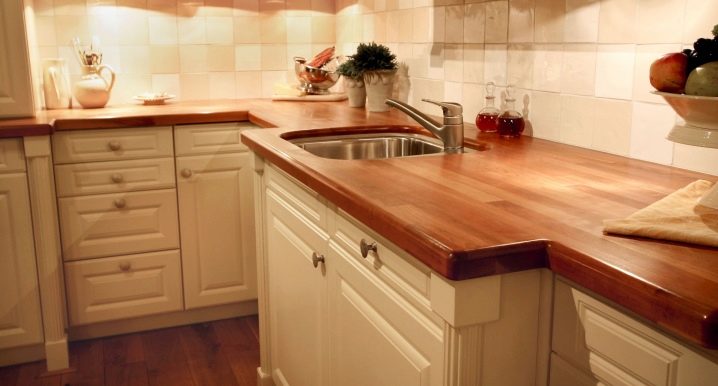
A wooden countertop in the kitchen is always a classic. But many do not know how to choose it so that it will serve for a long time and at an inexpensive price. How to choose and how to maintain cleanliness so that the tabletop will serve for a long time, read the article.
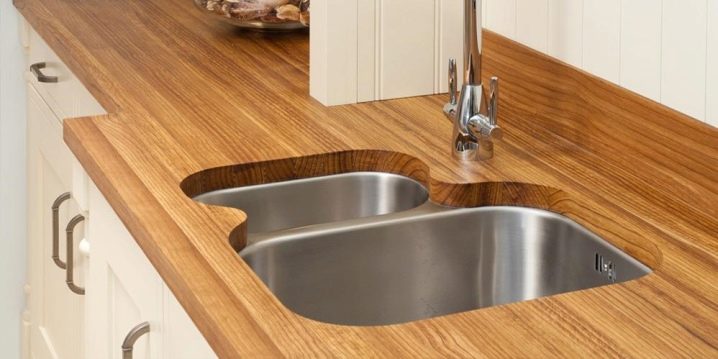
Advantages and disadvantages
The wood surface always looks presentable and expensive. But like any piece of furniture, kitchen countertops have pros and cons.
The pros are obvious:
- Natural materials. Wood is suitable for any style of kitchen. It perfectly matches both the interior of the classic design and the modern one. Environmentally friendly and safe surfaces.
- With proper care over time, consumers notice improvements in surface appearance. The drawing becomes more pronounced and saturated.
- No special products are required for care. The wooden worktop has anti-static properties, thanks to which dust does not settle on the surface, and dirt and stains are not too conspicuous.
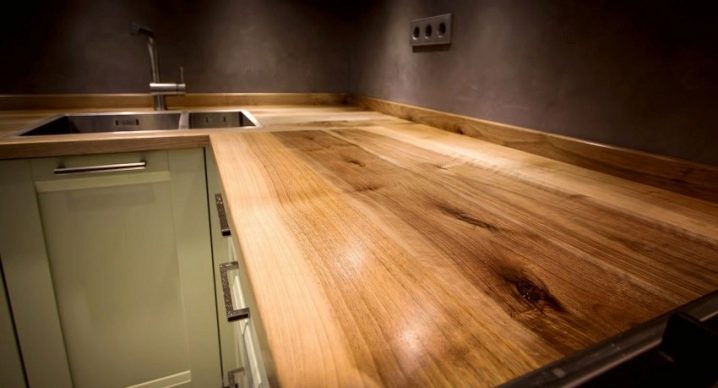
- If there are scratches, then they can be easily varnished, pre-treated with sandpaper. There is also a special wax on sale that will help wipe away scratches. It can only be used in the damaged area, while the varnish will have to be applied to the entire surface.
- Wooden countertops are not always expensive. Their price is 2-3 times lower than the cost of a natural stone surface. But at the same time, it is not much higher than the cost of laminated chipboard.
- Kitchen furniture is often made to order and has an irregular shape. Wood in this case is the most malleable material.
- Wood is an environmentally friendly materialabsolutely safe for children and pets. Perfect for those who prefer eco-style.
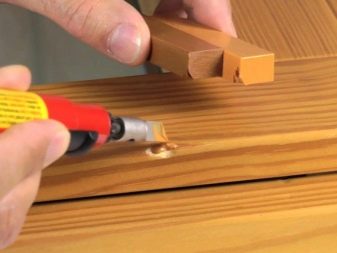
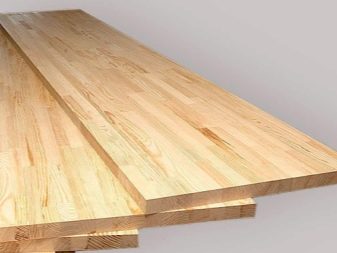
But, no matter how many positive qualities a wooden surface may have, there are also disadvantages.
- The wooden surface is rather "capricious". It can lose its original appearance from high humidity or temperature changes in the room.
- Additional treatment with oil or varnish is very important for wood. This takes an investment of time and money. But if you miss this point, then soon spots and scratches will appear on the surface, which will ruin not only the appearance, but also become the beginning of the appearance of mold.
- If moisture, juice or wine, alcohol gets on the surface, then there is a risk of getting all the same stains that cannot be removed.
- In order for the wooden tabletop to delight you for a long time, it is worth doing regular restoration. This will help maintain its original appearance throughout the entire period of operation.
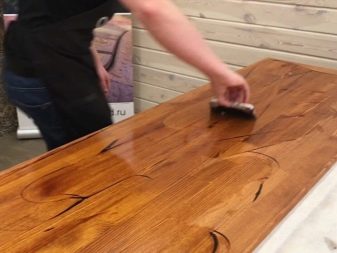
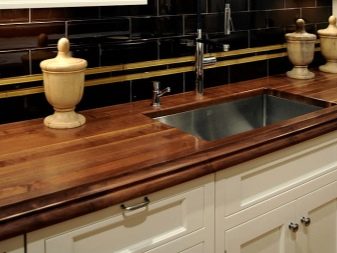
Views
Larch
A distinctive feature of larch from other natural wood species is that it can be used even in rooms with high humidity. This material does not rot. For example, even the piles in Venice are made of larch. In addition to the fact that larch does not rot, it has a number of other features:
- bacteria and microbes do not grow on the surface;
- maintenance is very simple and does not require special products, but it must be treated with oil once a year;
- the surface is able to withstand heavy loads and is resistant to mechanical stress;
- relatively low cost;
- beautiful appearance.
Not without drawbacks. Larch is less dense wood and can only withstand 1-2 restorations. Also, when buying, it should be borne in mind that such a tabletop can dry out over time.
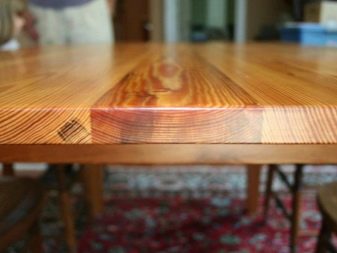

Oak
When it is necessary to choose a material for a countertop, the main criterion is the wear resistance of the product.
Pros of oak countertops:
- withstands changes in temperature and humidity;
- has good shock-absorbing properties, thereby eliminating the appearance of dents during mechanical stress;
- the oak work surface has a beautiful, noble color and will easily suit any interior;
- the surface does not absorb foreign odors, and is also not exposed to grease;
- a large selection of textures and shades from beige to noble brown.
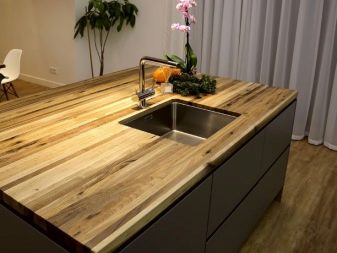
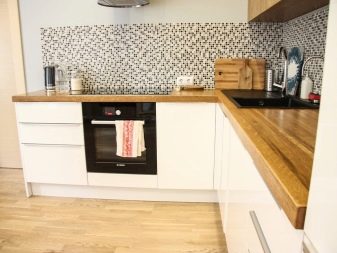
Minuses:
- rather high cost;
- the surface may wear out during operation, and in order to preserve its original appearance, it is necessary to carry out restoration (additionally varnished), which is not always convenient.
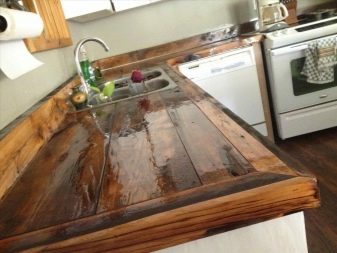
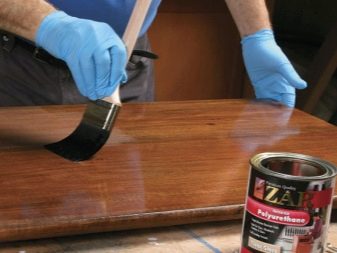
Beech
Beech kitchen worktops are highly durable and durable. A beautiful and noble light brown color, which is complemented by yellow or red shades. Beech countertops are perfect for classic interiors, and also go well with Baroque and Empire. But, it should be noted right away that such a tabletop should not be in the immediate vicinity of heating appliances. The surface will begin to crack. In the room, it is worth maintaining a constant mode of humidity and temperature, which is not very convenient.
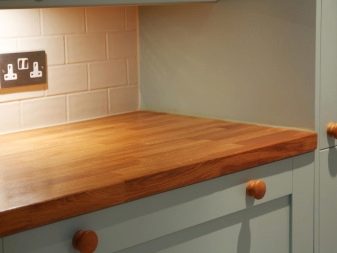
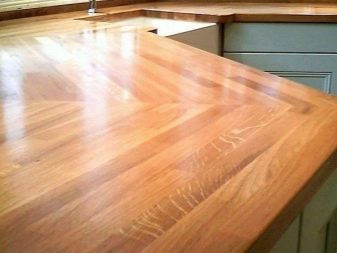
From cedar
The cedar countertop will suit everyone who wants a kitchen that is not like everyone else's. Cedar speaks of the refined taste of the owner and looks very presentable. Solid cedar countertops are very strong and durable. They easily withstand temperature and humidity changes. The surface color can be either light beige with a green tint or dark brown.

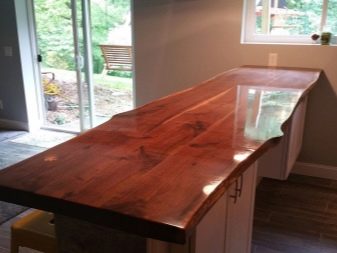
Pine
A pine countertop will have the most striking pattern as well as texture. Like the previous representatives, the solid pine surface easily tolerates high humidity. Pine is quite soft in nature, so the risk of dents and scratches is much higher than that of cedar. During use, the pine surface will emit a pleasant, coniferous scent that will fill the entire space around. Pine is the most affordable material, but you should choose from a trusted manufacturer. If the wood is dried and processed incorrectly, it will not only lead to a spoiled appearance, but also become a breeding ground for bacteria.
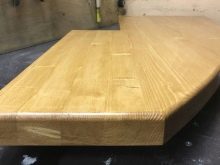


How to choose?
If you love wood and want to buy a kitchen countertop, then it is worth remembering some selection rules.
- Solid wood countertops can be divided into two types: made of wood and veneer. The second option assumes the use of MDF or chipboard as a basis. Of course, veneered surfaces are 2-3 times cheaper, and are also the most resistant to changes in temperature and humidity. Still, it is worth choosing the first option, which is more environmentally friendly and durable with proper care.
- Wear resistance is the main selection criterion. Oak and larch are suitable here.
- Wood species such as beech or elm are distinguished by a light shade. This color will look good in a Provence style interior or a classic one.
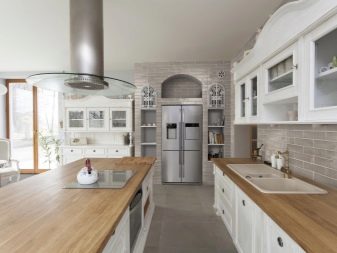
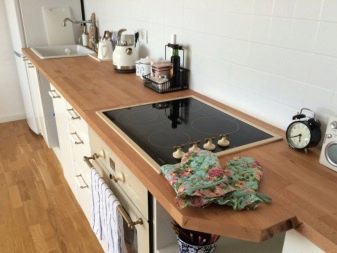
- It is worth choosing a countertop in accordance with the rest of the interior items. It should be in harmony with the colors and shades of the design.
- Before purchasing a natural wood countertop, it is worth checking the manufacturer. This will ensure that the material is environmentally friendly and safe. And also all the rules of storage and processing are observed.
- The kitchen surface has a standard thickness of 40-65 mm, but if you use a thickness of 23-45 mm, you can save a lot on price.
These simple tips will help you choose a quality and durable countertop.
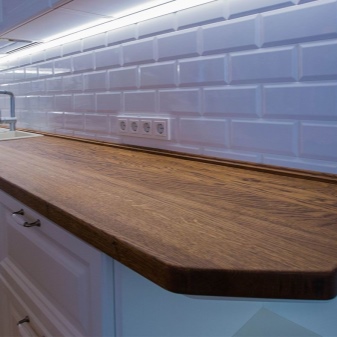
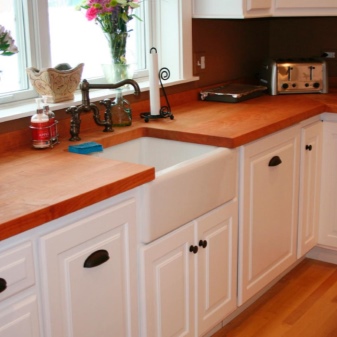
How to care?
As a rule, solid wood surfaces are sold untreated or partially finished.To maintain freshness and a beautiful appearance, the countertop must be coated with wood varnish or special wax oil. Oil processing is much more convenient. It can be applied more frequently than once a year, as required by the surface. Also, when a scratch appears, the oil will easily fill the gap. Oil painting a surface with oil is much easier.
The treated surface will become more resistant to the appearance of different types of stains.
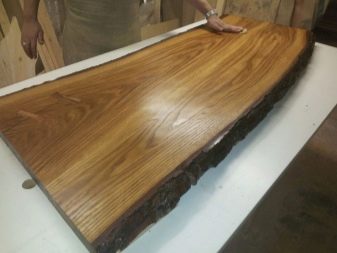
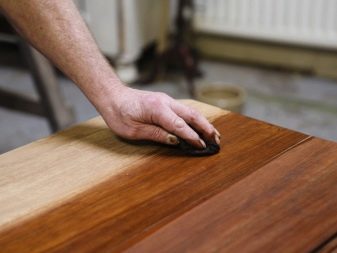
And even it will be able to withstand short-term contact with hot dishes. For everyday care, arm yourself with a damp soft cloth and soapy water. By wiping the surface daily, as well as as needed, you will keep the original noble appearance of natural wood for a long time. It is not worth covering the wooden countertop with paint. This can spoil the appearance and protective qualities of the material. Which, in turn, will entail a decrease in the service life.
Design options
- Photo # 1. This is the ideal way to use natural wood in your kitchen interior. Beautiful and noble color and texture emphasize the refined taste of the owner of this model. Natural wood lends itself well to milling, so the edges can be processed at any angle and shape you want.
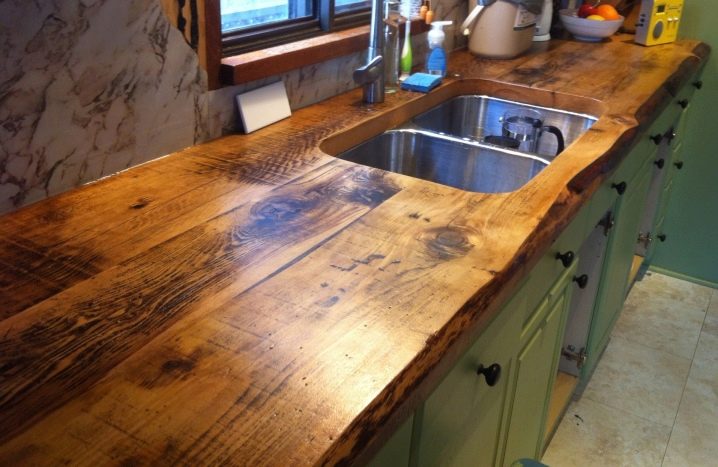
- Photo # 2. This example shows how you can use solid wood without trimming the edges. Natural convex and irregularly shaped cuts give the room a certain ecological subtext. If your kitchen is decorated in a modern eco-style, then this is an ideal option that both households and friends will appreciate.
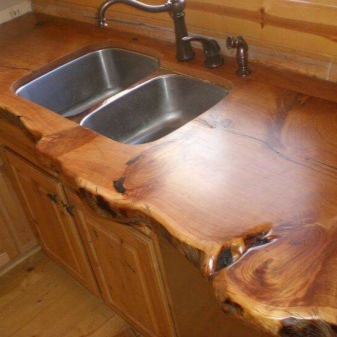

- Photo # 3. Beech top. The color of such a surface can be easily combined with any interior design. Light, with a clear texture, it will emphasize the softness and accuracy of the wearer. But do not forget that the countertop of this shade requires more careful maintenance in order to avoid the appearance of stains.
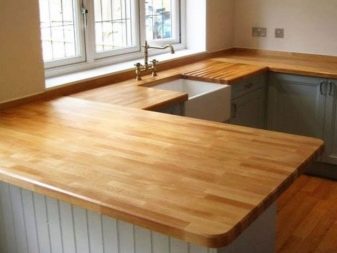

- Photo # 4. An example of a classic interior with a natural wood worktop. A beautiful combination of light shades of the headset and soft, noble wood. A good option for decorating a kitchen in a country house. But in the classic style, darker shades can also be used. And the countertop in this case will become a contrasting spot.
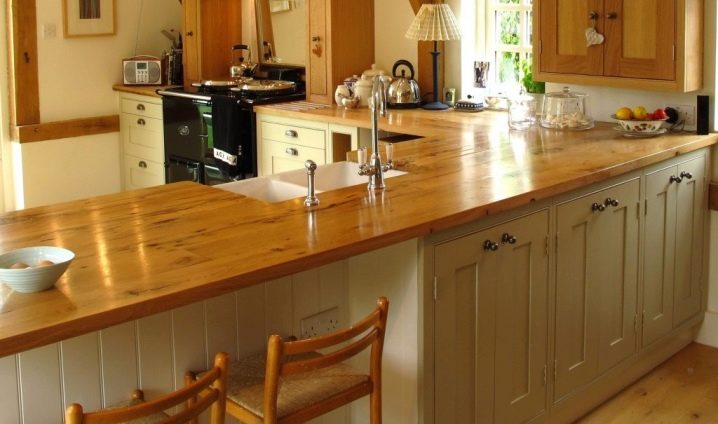
- Photo # 5. Dining area with a table made of natural wood. This is a raw cut of an array. Very original, but at the same time practical. This type of countertop will be appreciated by connoisseurs of eco-style in the interior. The surface color is suitable for both dark and light kitchens.
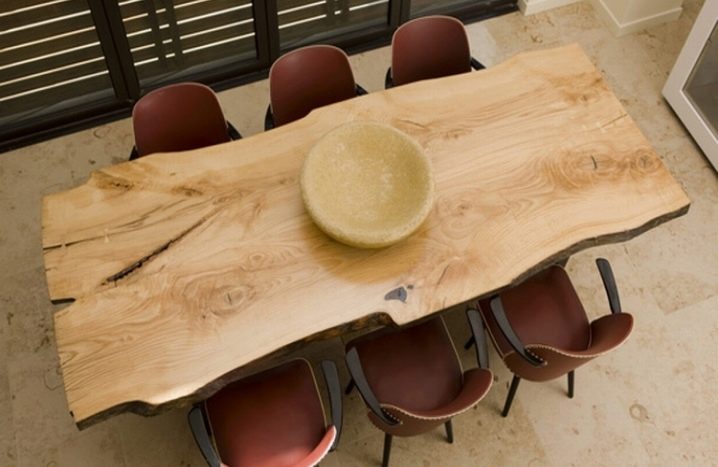
How to care for a wooden countertop in the kitchen, see the video below.













The comment was sent successfully.